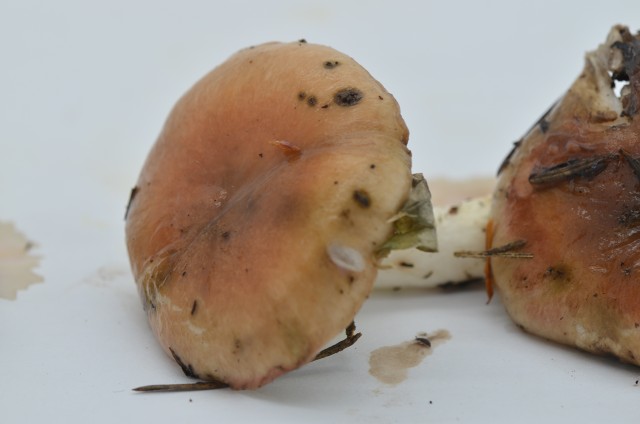If you can not find enough
Chanterelles, it may be easier to find
this mushromm that is also said to be edible
Gomphidius
More colorful names are:
Insidious Gomphidius and
Hideous Gomphidius
As to the species of Gomphidius:
Arora indicates that "about ten species occur in North America
all of them rather similar in appearance".
The mushrooms shown below are probably:
Gomphidius glutinosus or
Gomphidius oregonensis
Below, first the common characteristics of Gomphidius are discussed
and then there is a discussion of different species ---
--- scroll down for more pictures ----
Cap is
viscid or slimy when moist
smooth
color: salmon-buff to dull pinkish
gills
decurrent
wavy (not stright)
stipe
lower portion - bright yellow
spores
smokey-gray to black
Gills are decurrent
and wavy
Bottom of stipe is bright yellow
Slimy Cap
decurrent gills
Smokey-gray to blck spores
Yellow on base of stipe
Arora Says
Gomphidius species are edible
He suggests peeling off the slimy skin
Question: Are they desirable
Remember: be careful and safe
Always sample a little bit of a new mushroom first
Never eat a large amount without first testing
(more than once) to be certain it has no ill effects.
Finally a note about the two species:
Gomphidius glutinosus and Gomphidius oregonensis.
In order to positively tell the difference between G. oregonensis
and G. glutinosus
one must measure the spores.
The spores of Gomphidius oregonensis are larger
than the spores of Gomphidius glutinosus
Pictures of spores are given below.
Without measuring the spores there are some hints as to species:
G. oregonensis normally grows in clusers,
G. glutinosus do not normally grow in clusters
G. glutinosus normally fruits in the vicinity of Suillus.
Usually G. oregonensis has a gray cap.
The cap of G. glutinosus may be pinker.
The following is some additional info
on various species of Gomphidius
This is a picture at 2000x
of the spores of G. oregonensis
They are oblong
and they are
11 to 12 microns long and
4 to 5 microns wide
The following are photographs
of Gomphidius oregonensis
from our 2007 OMS show
Note the growth in a group
This is called cespitose
Photos courtesy of Lorelei N.
The following is a photograph
of Gomphidius subroseus
from our 2007 OMS show
Note the redish or pink
cap color
Photos courtesy of Lorelei N.
The conclusion:
It is vbery hard to determine the
specific species of a Gomphidius mushroom
without the use of a microscope
Do offer some comments: Message will go to Elmer
Type your message in the box below and include your name
If you want to see more pictures
Click on a thumbnail to enlarge

1.
|

2.
|

3.
|

4.
|

5.
|

6.
|

7.
|

8.
|

9.
|

10.
|

11.
|

12.
|

13.
|

14.
|

15.
|

16.
|

17.
|

18.
|

19.
|

20.
|

21.
|

22.
|

23.
|

24.
|

25.
|

26.
|

27.
|

28.
|

29.
|



























